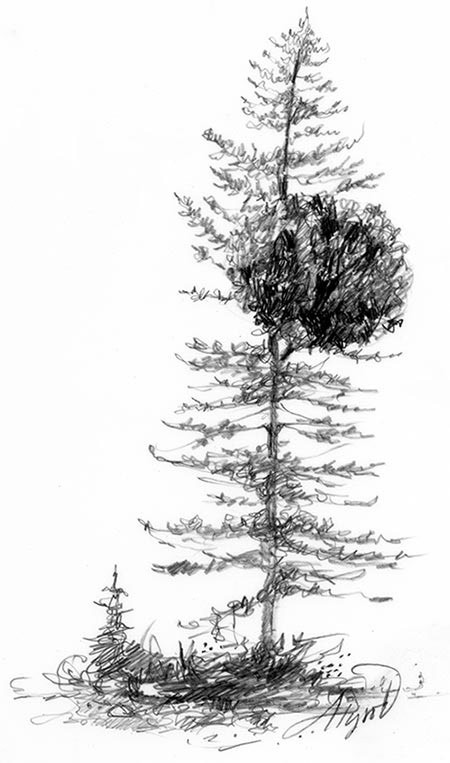
One of my family’s cherished Christmas traditions, back at our farm in Virginia, is to search out mistletoe balls growing high in the hedgerows. Then we take out a 20-gauge shotgun and blast them to pieces.
We aren’t doing this out of Yuletide spite – there’s simply no other practical way to harvest a plant that grows on thin branches high above the ground. When peppered with bird shot, oak mistletoe (Phoradendron leucarpum) rains down in sprigs. These look pretty tied up in ribbons and hung from a chandelier.
In Vermont and New Hampshire, mistletoe balls are out of reach in an absolute sense; they don’t grow here. So, as I’ve been feeling homesick these past weeks, I decided to find out what mistletoe species live this far north.
That's how I discovered eastern dwarf mistletoe. It’s a small, homely plant, although it does have an interesting visual impact on spruce boughs. It’s also trigger-happy. It turns out mistletoe in these parts doesn’t get shot – it shoots. And its frequent target is Christmas trees.
Arceuthobium pusillum grows on spruce trees (most frequently on black spruce), and less commonly on other conifers. It is one of nineteen species of dwarf mistletoe native to the United States.
Like all mistletoes, it’s parasitic. Although capable of photosynthesis, it harvests most of its minerals, sugar, and water from the tissue of its host tree. For most of its life it lives hidden from view, under its host tree’s bark. An extensive web of cortical strands (imagine the runners of ground-growing ivy) connect to “sinkers” – similar in their function to roots – which harvest nutrients from the tree’s living tissue and anchor themselves to the wood.
Signs of the plant’s presence in a tree include crown dieback, swollen branches, and messy, dense patches of growth called “witches’ brooms.” (Although any of these infestation symptoms may have other causes.)
Although dwarf mistletoes can be serious forests pests in other parts of North America, none of the foresters I checked with seemed much concerned with A. pusillum. Marshall Patmos, the former county forester for Cheshire County, New Hampshire and a Christmas tree farmer, takes a tolerant view of mistletoe infestations. Many Christmas tree customers, he says, prefer trees with a little character. The “elf shelves” created by mistletoe and other tree parasites have quirky appeal, as do old bird nests and even damage from moose browsing.
Whatever the decorative merits of its witches’ brooms, the plant’s strategy for seed dispersal is downright awe inspiring. Unlike leafy mistletoe, which relies mainly on birds, dwarf mistletoe turns its seeds into ammunition.
In early spring, approximately five years after the plant germinates, it sends up sprouts. These grow about three centimeters high before producing drab, greenish-brownish flowers. Once pollination occurs, male sprouts wither and fall off. (The empty basal cups, where sprouts once grew, look a bit like sapsucker holes.) The female sprouts linger until autumn, incubating single-seeded berries.
So how does the mistletoe launch its seeds? Professor Cynthia Marie Ross Friedman of Thompson Rivers University in British Columbia, an authority on dwarf mistletoes, explained the process to me. As each berry ripens, a mucilaginous layer of cells called viscin develops underneath the seed. The viscin attracts water from the rest of the plant, resulting in increasing hydrostatic pressure in the berry. At the same time, on the opposite upper side of the berry, cells begin to die off near the stem. Eventually, a trigger point is reached. The berry explodes off the stem and the seed is launched into the air at a 45 degree angle – the ideal angle for maximum range. Seed speeds may reach fifty miles an hour, and seeds have been known to travel as far as sixty feet.
If this seed bullet hits a tree, the sticky viscin helps it adhere to its victim, and stay there all winter. The following spring, a tiny sprout will emerge from the seed and dig into the host tree’s bark.
This past weekend, as my Vermont family – unarmed – tromped through the woods in search of Christmas tree, I kept a lookout for swollen branches and witches’ brooms. While I had no interest in taking eastern dwarf mistletoe home with us, I would have liked to indulge in a group hug beneath an infested bough, perhaps accompanied by an off-key round of Good King Wenceslas.
Alas, it was not to be. There was no sign of mistletoe in our woodlot. We ended up harvesting an oddly perfect young spruce, the kind that would have left some of Marshall Patmos’s quirkier customers wistful for moose. As for the hallway chandelier (OK, light fixture), I’m still looking for substitute greenery. Deck the halls with invasive buckthorn?


Discussion *